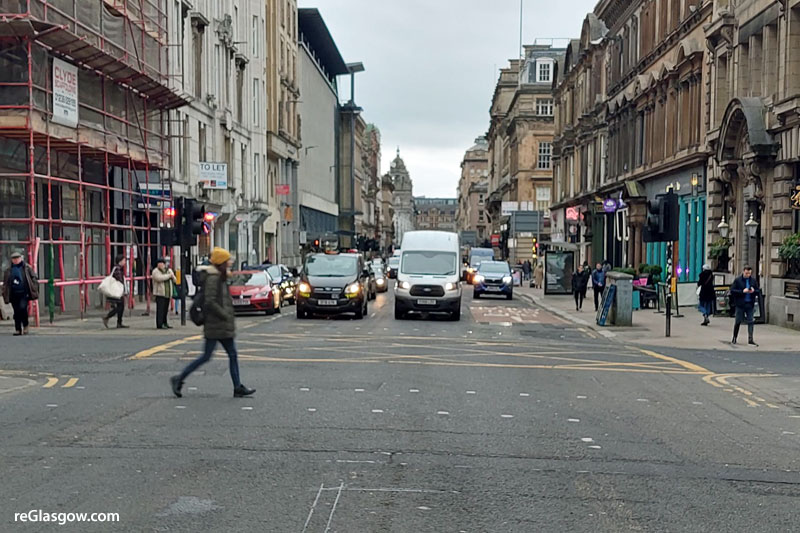
GLASGOW’S draft City Centre Transformation Plan has been published, giving details of a ‘People First Zone’ in which ‘vehicles are the guests’.
The plan is due to be put out for public consultation later this year.
The ‘People First Zone’ would cover the area bounded by Hope Street, Cowcaddens Road, North Hanover Street / Glassford Street and Howard Street.
Access would still be available for pick-up and drop-off at key transport hubs, and disabled access would be maintained.
A report updating councillors states: “The transformation plan has a people-based focus addressing the needs of place and movement and the additional vitality and vibrancy that well connected, safe and appealing places create.
“The Sustainable Travel Hierarchy underpins the transformation plan with its promotion of walking, wheeling, cycling, public transport and bike, car and ride sharing in preference to single occupancy car use.
“Within the strategy it has been identified that there are a number of catalyst areas that will help us achieve our aims. These include projects that are already committed and have secured funding through City Deal and our future aspirations.”
Committed Funding
• George Square — Putting ‘Great Spaces’ in the heart of the city
• Glasgow Avenues Programme — Creating streets prioritising active travel and place
Future Aspirations –
• City Centre People First Zone — People-friendly, low vehicular access zone
• Future Avenues — Creating streets prioritising active travel and place
• Broomielaw and Clyde Waterfront — Re-connecting the city with its waterfront
• Buchanan Street Gateway — Creating a new connected greenspace gateway
• High Street Corridor — Promoting liveable places
• Mitchell Plaza and Charing Cross — Mitigating the impact of an urban motorway
• People Friendly Streets — Developing low traffic-dependent, liveable neighbourhoods within the city centre
The report adds: “A key element of the strategy is the concept of the creation of a ‘City Centre People First Zone’. This would be a high quality, public realm area where people are able to easily and safely walk and wheel around; where people feel they have priority and vehicles are the guests.
“This would mean that crossing points are much wider and pedestrians have less distance and more time to cross roads; the environment feels much more pleasant with less noise and cleaner air.
“The aim of this zone would be to limit access to essential vehicle use only and encourage a move away from general car use.
“This would enable the space to be re-purposed, with on street parking primarily being removed within this zone; utilising road space to secure a high-quality public realm with fully integrated active travel provision, civic spaces, pocket parks or parklets and street cafes.
The zone would cover the area bounded by Hope Street, Cowcaddens Road, North Hanover Street / Glassford Street and Howard Street.
Access would still be available for pick-up and drop-off at key transport hubs, and disabled access would be maintained.
The report continues: “This scheme is ambitious and will require careful consideration of challenges. Detailed analysis into the wider operation of the zone to assess all the access and servicing requirements, operational hours and exemptions will need to be undertaken.
“It will be imperative that we undertake extensive public consultation, and partnership working will be required for effective delivery. As part of the design and consultation process for each street or area, we will consider the full range of potential impacts and ways to address them, including ensuring the personal security for people.
“This may include considering lighting or the option to have different restrictions in day-time and night-time hours, to ensure spaces are fully animated throughout the day.
“This will also provide the opportunity to tie in with the wider masterplans that are being undertaken for both Buchanan Galleries and St Enoch Centres that will both fall within the boundaries of the zone.”
The document further states: “It is proposed that any transformation of the city centre core area would best be developed on a phased basis, incrementally tying into other city initiatives and building on them so that by 2027 we would have a ‘car free’ city centre core, with limited access for the private car but maintaining access for public transport, residential and commercial properties, and disabled road users.
“The first stage of this can be seen with the temporary changes that have been introduced on George Square and St Vincent Street where the benefits of repurposing space can be seen.”
It concludes: “The proposals aim to support our short-term recovery following the Covid-19 pandemic, and to support delivery of our vision for the city centre for an integrated, healthy, inclusive and sustainable transport network with increased connectivity and capacity.
“They will help to deliver growth in a sustainable way and to support our target for 80 per cent of people using public transport and active travel to get into the city centre in the peak period by 2030.
“Our proposals also reflect our desire to make walking or wheeling the main mode of travel for getting around the city centre and creating high quality streets and public spaces that are welcoming and easy to move around.
“All our planned proposals support the transformation needed to shift towards a net-zero carbon city centre and cleaner air.”


